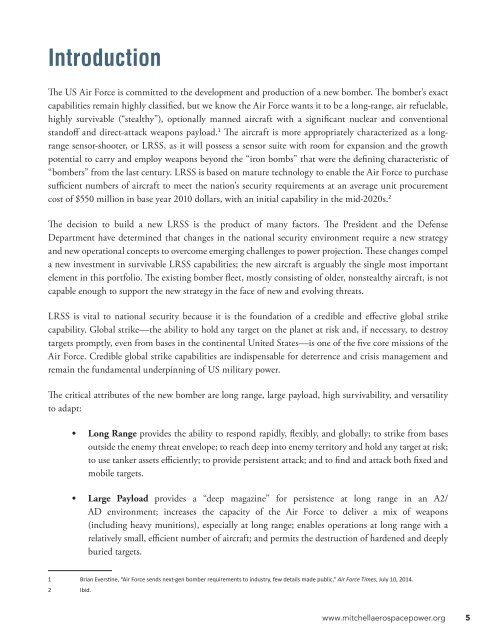Create successful ePaper yourself
Turn your PDF publications into a flip-book with our unique Google optimized e-Paper software.
Introduction<br />
The US Air Force is committed to the development and production of a new bomber. The bomber’s exact<br />
capabilities remain highly classified, but we know the Air Force wants it to be a long-range, air refuelable,<br />
highly survivable (“stealthy”), optionally manned aircraft with a significant nuclear and conventional<br />
standoff and direct-attack weapons payload. 1 The aircraft is more appropriately characterized as a longrange<br />
sensor-shooter, or LRSS, as it will possess a sensor suite with room for expansion and the growth<br />
potential to carry and employ weapons beyond the “iron bombs” that were the defining characteristic of<br />
“bombers” from the last century. LRSS is based on mature technology to enable the Air Force to purchase<br />
sufficient numbers of aircraft to meet the nation’s security requirements at an average unit procurement<br />
cost of $550 million in base year 2010 dollars, with an initial capability in the mid-2020s. 2<br />
The decision to build a new LRSS is the product of many factors. The President and the Defense<br />
Department have determined that changes in the national security environment require a new strategy<br />
and new operational concepts to overcome emerging challenges to power projection. These changes compel<br />
a new investment in survivable LRSS capabilities; the new aircraft is arguably the single most important<br />
element in this portfolio. The existing bomber fleet, mostly consisting of older, nonstealthy aircraft, is not<br />
capable enough to support the new strategy in the face of new and evolving threats.<br />
LRSS is vital to national security because it is the foundation of a credible and effective global strike<br />
capability. Global strike—the ability to hold any target on the planet at risk and, if necessary, to destroy<br />
targets promptly, even from bases in the continental United States—is one of the five core missions of the<br />
Air Force. Credible global strike capabilities are indispensable for deterrence and crisis management and<br />
remain the fundamental underpinning of US military power.<br />
The critical attributes of the new bomber are long range, large payload, high survivability, and versatility<br />
to adapt:<br />
• Long Range provides the ability to respond rapidly, flexibly, and globally; to strike from bases<br />
outside the enemy threat envelope; to reach deep into enemy territory and hold any target at risk;<br />
to use tanker assets efficiently; to provide persistent attack; and to find and attack both fixed and<br />
mobile targets.<br />
• Large Payload provides a “deep magazine” for persistence at long range in an A2/<br />
AD environment; increases the capacity of the Air Force to deliver a mix of weapons<br />
(including heavy munitions), especially at long range; enables operations at long range with a<br />
relatively small, efficient number of aircraft; and permits the destruction of hardened and deeply<br />
buried targets.<br />
1 Brian Everstine, “Air Force sends next-gen bomber requirements to industry, few details made public,” Air Force Times, July 10, 2014.<br />
2 Ibid.<br />
www.mitchellaerospacepower.org 5


